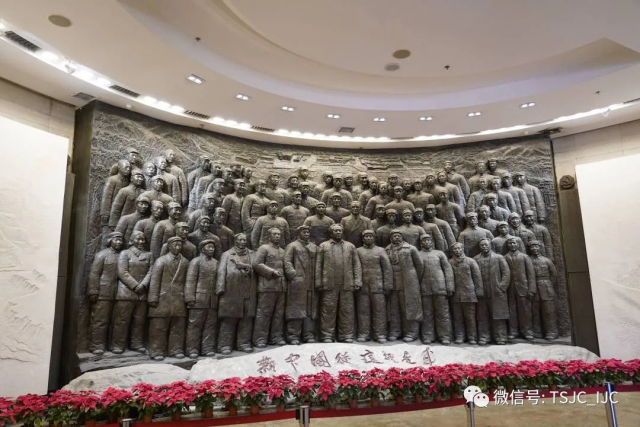11
2020.11
Dark bronze, one-meter tall, quite dusty– Chinese Communist Party (CPC)’s first cash printer stood in a corner at the Xibaipo Memorial Hall, with a group of Tsinghua University’s journalism students around, listening to the tour guide, and taking pictures.
The printing machine is only one of the many displays that interested them: a pearl tree planted in Mao Zedong’s former residence, trolleys the People’s Liberation Army once used to deliver supplies to peasants, soldiers’ shoes, and so forth.

A Display at the Xibaipo Memorial Hall. Photo by 陈佳颖
The 18 graduate students from School of Journalism and Communication, Tsinghua University, visited the Xibaipo Memorial Hall in northern China’s Hebei Province on Friday during a field research trip.
“Seeing the trolley, I was able to link together all the events I’d read in history books when I was 11,” said Liu Yongliang, 22, one of the students.
“It felt quite amazing when the historical stories I had read before got intertwined with what I was seeing in the real world,” Liu said.
The success of the Huaihai Battle of 1948 lies in the trolleys. The ordinary people used them to deliver supplies to help the army win, Liu added. The battle is one of the three major battles in China’s liberation war.
About 350 kilometers southwest of Beijing, Xibaipo once served as the headquarter of the CPC Central Committee. The 18 international journalism major students visited the site as the Party is about to celebrate its 100th anniversary of foundation next year.
“It is crucial for students to understand who you are and reflect on your identity,” said Zhang Yaozhong, 28, a PhD student from the journalism school and also the teaching assistant.
Xibaipo, with Taihang Mountain nearby as a geographical advantage, became the new commanding site after Kuomintang attacked Yan’an, the former headquarter of CPC, unexpectedly.
The Party commanded three major battles, Liao, Huaihai and Ping and Tianjin, in Xibaipo. Therefore, this place has enjoyed the reputation of “new China came from here.”
“The peace we enjoy today is not meant to be, so we should not take it for granted. It was built through hardships and struggles by the forefathers. It is through constant experiments like those in Xibaipo that made our life possible,” said another student Zhang Jinniu, 23.
Zhang added that this trip encouraged him to value our lives and to pass on the spirit.
In Xibaipo, the Party leaders started to explore ways to govern a new China rather than just focusing on winning battles, so it paved ways for them to run the country later on.
In the late 1940s, the Party trailed its earliest financial system here. The Party also launched the Land Reform in Xibaipo to give out farmlands to peasants. New strategical priorities were also sorted out during two important conferences here.

Students' Photo in Front of the Memorial. Photo by 马姚姚
The journalism students visited 12 exhibitions in the hall, which showed the Party’s major events in a sequential order.
The day trip to Xibaipo is one of a six-day field research trip, where three veteran journalists from Xinhua News Agency, China Daily and the All-China Journalists Association workshopped stories with the journalism students.

2025.12.16 15:15
16
2025.12
16
2025.12
16
2025.12
 28:32
28:32
2025.06.19 08:55